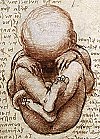
Back Taalverwerwing Afrikaans اكتساب اللغة Arabic Езиково развитие Bulgarian মাতৃভাষা অর্জন Bengali/Bangla Adquisició del llenguatge Catalan Osvojování jazyka Czech Sproglig udvikling Danish Spracherwerb German Γλωσσική κατάκτηση Greek Akirado de lingvaĵo Esperanto
| Part of a series on |
| Linguistics |
|---|
|
|
| Part of a series on |
| Human growth and development |
|---|
 |
| Stages |
| Biological milestones |
| Development and psychology |
Language acquisition is the process by which humans acquire the capacity to perceive and comprehend language. In other words, it is how human beings gain the ability to be aware of language, to understand it, and to produce and use words and sentences to communicate.
Language acquisition involves structures, rules, and representation. The capacity to successfully use language requires human beings to acquire a range of tools, including phonology, morphology, syntax, semantics, and an extensive vocabulary. Language can be vocalized as in speech, or manual as in sign.[1] Human language capacity is represented in the brain. Even though human language capacity is finite, one can say and understand an infinite number of sentences, which is based on a syntactic principle called recursion. Evidence suggests that every individual has three recursive mechanisms that allow sentences to go indeterminately. These three mechanisms are: relativization, complementation and coordination.[2]
There are two main guiding principles in first-language acquisition: speech perception always precedes speech production, and the gradually evolving system by which a child learns a language is built up one step at a time, beginning with the distinction between individual phonemes.[3]
For many years, linguists interested in child language acquisition have questioned how language is acquired. Lidz et al. state, "The question of how these structures are acquired, then, is more properly understood as the question of how a learner takes the surface forms in the input and converts them into abstract linguistic rules and representations."[4]
Language acquisition usually refers to first-language acquisition. It studies infants' acquisition of their native language, whether that is a spoken language or a sign language,[1] though it can also refer to bilingual first language acquisition (BFLA), referring to an infant's simultaneous acquisition of two native languages.[5][6][7][8][9][10][11] This is distinguished from second-language acquisition, which deals with the acquisition (in both children and adults) of additional languages. On top of speech, reading and writing a language with an entirely different script increases the complexities of true foreign language literacy. Language acquisition is one of the quintessential human traits.[12][13]
- ^ a b Pichler, Chen (2015). "Language Learning through the Eye and Ear Webcast". Laurent Clerc National Deaf Education Center. Gallaudet University. Archived from the original on 15 December 2020. Retrieved 17 December 2023.
- ^ Lightfoot, David (2010). "Language acquisition and language change". Wiley Interdisciplinary Reviews: Cognitive Science. 1 (5): 677–684. doi:10.1002/wcs.39. ISSN 1939-5078. PMID 26271652.
- ^ Fry, Dennis (1977). Homo loquens, Man as a talking animal. Cambridge University Press. pp. 107–108. ISBN 978-0-521-29239-9.
- ^ Lidz, Jeffrey; Waxman (16 April 2003). "What infants know about syntax but couldn't have learned:experimental evidence for syntactic structure at 18 months" (PDF). Cognition 89 (2003) B65-B73. Archived from the original (PDF) on 12 December 2017. Retrieved 12 December 2017 – via Elsevier science.
- ^ Bergman, Coral Rhodes (1976). "Interference vs. independent development in infant bilingualism". In Keller, Gary D.; Teschner, Richard V.; Viera, Silvia (eds.). Bilingualism in the Bicentennial and Beyond. Bilingual Press. pp. 86–96. ISBN 9780916950019.
- ^ Genesee, Fred (1989). "Early bilingual development: One language or two?". Journal of Child Language. 16 (1): 161–179. doi:10.1017/S0305000900013490. PMID 2647777. S2CID 20680592.
- ^ de Houwer, Annick (1990). The Acquisition of Two Languages from Birth. Cambridge University Press. ISBN 9780511519789.
- ^ de Houwer, Annick (1996). "Bilingual Language Acquisition". In Fletcher, Paul; MacWhinney, Brian (eds.). The Handbook of Child Language. Wiley-Blackwell. ISBN 978-0-631-20312-4.
- ^ Hulk, Aafke; Müller, Natascha (December 2000). "Bilingual first language acquisition at the interface between syntax and pragmatics". Bilingualism: Language and Cognition. 3 (3): 227–244. doi:10.1017/S1366728900000353.
- ^ Paradis, Johanne; Genesee, Fred (1996). "SYNTACTIC ACQUISITION IN BILINGUAL CHILDREN: Autonomous or Interdependent?" (PDF). Studies in Second Language Acquisition. 18 (1): 1–25. doi:10.1017/S0272263100014662. JSTOR 44487857. S2CID 143994688.
- ^ Serratrice, Ludovica; Sorace, Antonella; Paoli, Sandra (2004). "Crosslinguistic influence at the syntax–pragmatics interface: Subjects and objects in English–Italian bilingual and monolingual acquisition" (PDF). Bilingualism: Language and Cognition. 7 (3): 183–205. doi:10.1017/S1366728904001610. S2CID 38643617.
- ^ Friederici, AD. (Oct 2011). "The brain basis of language processing: from structure to function". Physiol Rev. 91 (4): 1357–92. CiteSeerX 10.1.1.385.5620. doi:10.1152/physrev.00006.2011. PMID 22013214. S2CID 3224368.
- ^ Kosslyn, Stephen M.; Osherson, Daniel N. (1995). An invitation to cognitive science. Cambridge, Mass.: MIT Press. ISBN 978-0-262-65045-8. OCLC 613819557.